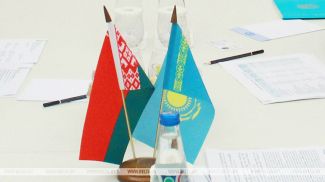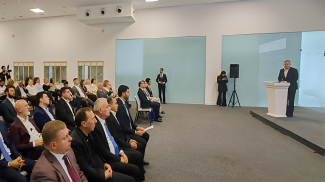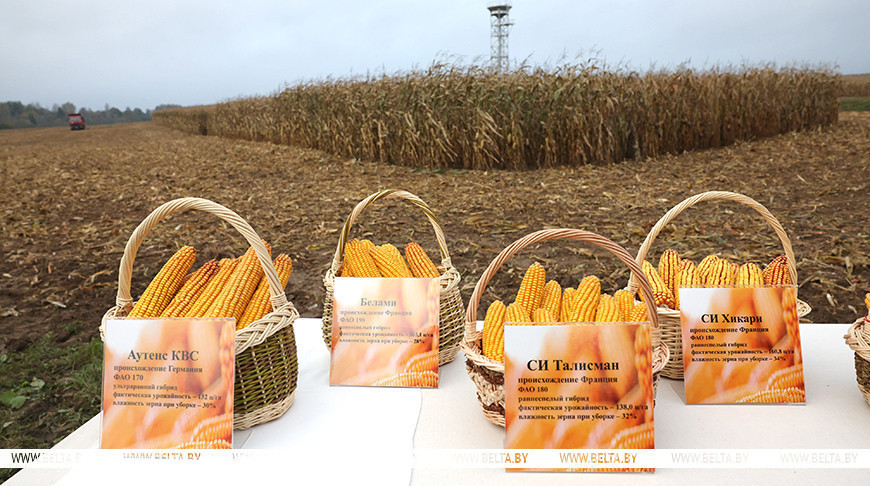
Aleksandr Lukashenko spent Friday, 11 October, in his hometown, literally in the presidential fields where the head of state often experiments with certain crops to understand the best course of action in agriculture on a regional or even national scale. This year, the focus is on maize, an important crop for animal husbandry. It is grown both for grain and silage. Farmers always have a choice of seeds of Belarusian and foreign varieties. But what is better is the main question. To solve it, 12 different varieties were planted in the field, half of which were domestic ones. Equal care and full compliance with all technology were ensured. We looked into how the maize experiment ended and why farmers should not be afraid of Belarusian maize varieties. The details were shared by Director of the Polessky Institute of Horticulture Leonid Shimansky. It was he who reported to the head of state in the field.
A lot has already been written about the experiment and the event with the participation of the president, but the issue deserves a closer look. The attitude to Belarusian maize varieties is sometimes ambiguous still, and the farmers themselves told Aleksandr Lukashenko that foreign varieties yield about 20% more grain. However, everything is not as it may seem at first glance, including the results of the experiment.
Firstly, foreign varieties are primarily intended for grain while domestic scientists have mainly worked on silage maize.
Secondly, at the time of the president's arrival, all foreign varieties were harvested (they have a faster ripening period). Only one Belarusian variety, namely Polessky 175 СВ, was removed. The yield of the latter was 112 centners/ha with a moisture content of 35%. The French Fashion variety has the same yield with a moisture content of 29%, i.e. cumulatively it is slightly superior to its Belarusian counterpart. Another two French varieties yielded 160 centners/ha. However, the hybrid Polessky 202, which was still in the field, is expected to yield around 162 centners/ha.
“You always say that the most important thing is dictatorship in technology. Everything has been done as you said. This dictatorship allows us to fulfill the potential of both silage and grain hybrids. We are not behind in terms of yield," director of the Polessky Institute of Horticulture Leonid Shimansky said.
Aleksandr Lukashenko decided to ask the practitioner - Director of OAO Alexandriyskoye Dmitry Malashenko. He said that the domestic grain maize varieties still yield 20% less than the best foreign competitors. Other participants in the conversation agreed with this assessment, including, for example, Chairman of the Shklov District Executive Committee Sergei Bartosh, former agriculture and food minister.
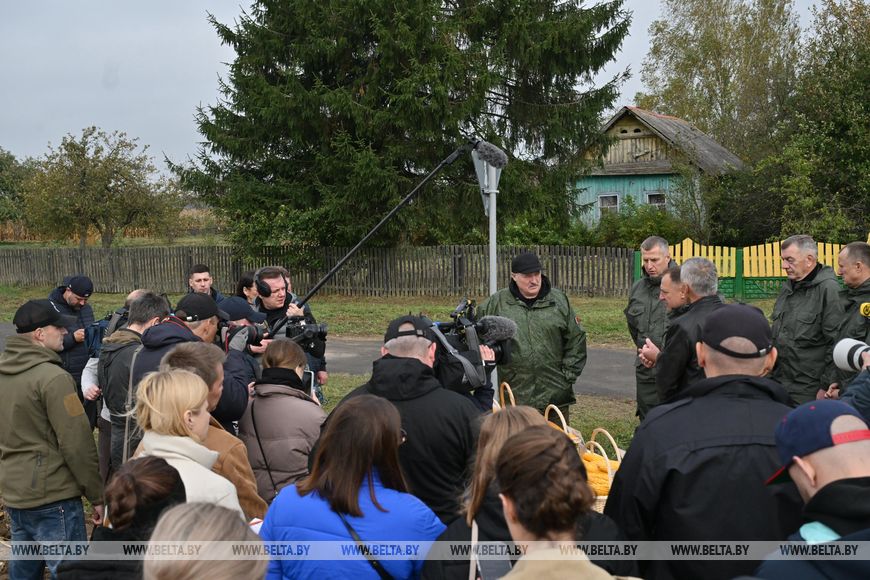
The conclusion, which neither the scientist, nor the practitioners, nor the government officials could formulate succinctly, was voiced by Aleksandr Lukashenko himself: "Our maize is not bad, it is true. But we are lagging behind the West."
The president also spoke about the performance of the scientific sector, including plant breeders. An ad-hoc commission has been set up to look into the effectiveness throughout the system of the National Academy of Sciences.
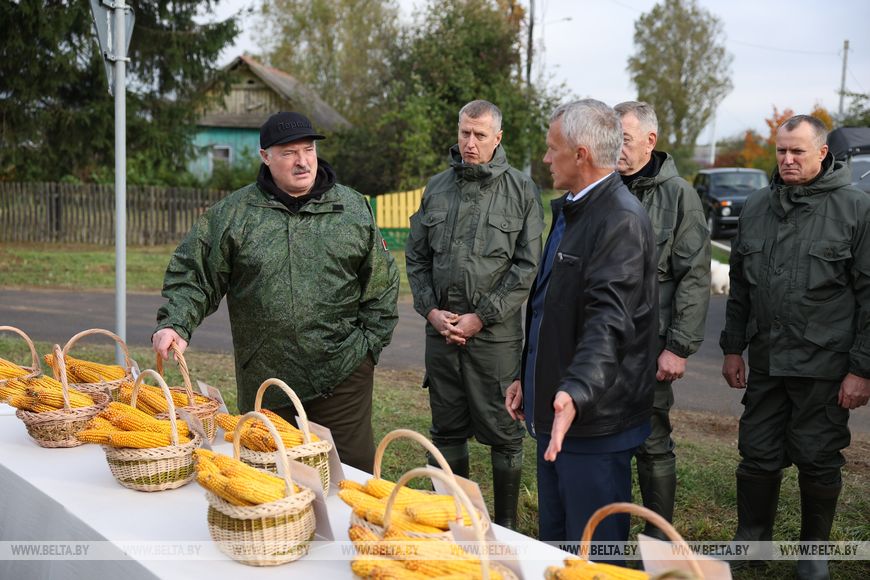


A lot has already been written about the experiment and the event with the participation of the president, but the issue deserves a closer look. The attitude to Belarusian maize varieties is sometimes ambiguous still, and the farmers themselves told Aleksandr Lukashenko that foreign varieties yield about 20% more grain. However, everything is not as it may seem at first glance, including the results of the experiment.
Secondly, at the time of the president's arrival, all foreign varieties were harvested (they have a faster ripening period). Only one Belarusian variety, namely Polessky 175 СВ, was removed. The yield of the latter was 112 centners/ha with a moisture content of 35%. The French Fashion variety has the same yield with a moisture content of 29%, i.e. cumulatively it is slightly superior to its Belarusian counterpart. Another two French varieties yielded 160 centners/ha. However, the hybrid Polessky 202, which was still in the field, is expected to yield around 162 centners/ha.
“You always say that the most important thing is dictatorship in technology. Everything has been done as you said. This dictatorship allows us to fulfill the potential of both silage and grain hybrids. We are not behind in terms of yield," director of the Polessky Institute of Horticulture Leonid Shimansky said.
"Currently, we are competing with over 30 foreign companies in maize selection. There is no such competition for any other crop. I think we will maintain this level."
It would seem that the domestic silage varieties are quite close to foreign ones in terms of yield. But the scientist would not say that the Belarusians have surpassed the foreign varieties that, too, produced very varying yields.
It would seem that the domestic silage varieties are quite close to foreign ones in terms of yield. But the scientist would not say that the Belarusians have surpassed the foreign varieties that, too, produced very varying yields.
Aleksandr Lukashenko decided to ask the practitioner - Director of OAO Alexandriyskoye Dmitry Malashenko. He said that the domestic grain maize varieties still yield 20% less than the best foreign competitors. Other participants in the conversation agreed with this assessment, including, for example, Chairman of the Shklov District Executive Committee Sergei Bartosh, former agriculture and food minister.

The conclusion, which neither the scientist, nor the practitioners, nor the government officials could formulate succinctly, was voiced by Aleksandr Lukashenko himself: "Our maize is not bad, it is true. But we are lagging behind the West."
The president also spoke about the performance of the scientific sector, including plant breeders. An ad-hoc commission has been set up to look into the effectiveness throughout the system of the National Academy of Sciences.
"We will take you, scientists, to task if you fail. You must produce results. No misrepresentation or window dressing will be tolerated. Why cultivate something that we don't need? We need high-yielding, good varieties. We should thoroughly study the performance of these varieties. Not everything is fine yet. Domestic varieties lag behind imported ones despite all the support that we provide to our scientists," Aleksandr Lukashenko said.
Indeed, foreign maize ripens faster and has lower grain moisture, which is also important. It usually produces higher yields. Foreign varieties can as well be harvested for silage, as they have a good green mass.
Leonid Shimansky told us in detail how things are with Belarusian varieties, and whether domestic breeders have aces up their sleeve.
Is it all about money or not? What's holding back Belarusian maize breeders?
Financial investments in science are definitely important. Large transnational players invest millions in the development of new varieties almost daily. It is impossible to out-invest them, and it is not necessary. Belarusian varieties have their own advantages.
"Belarusian hybrids are developed here. They were created on this land and adapted to all unfavorable conditions. For example, they are more drought-resistant than Western ones. In such years [2024 was very good for maize] Western ones perform a little better," the scientist said.

In general, the outcomes of the work of Belarusian breeders are at the world's average despite the high competition. But the main obstacle is the climate.
"We are the northernmost place in the world for selection and seed production [of maize]. We have limited thermal resources, i.e. we cannot work with the plasma that all the well-known companies work with. Because their varieties are meant for areas located much further south than ours. Thus, they have the opportunity to use good plasma to obtain hybrids," said Leonid Shimansky.
First of all, this is why you cannot punch above your weight in some aspects. For example, in terms of early maturity, the majority of Belarusian hybrids have the maturity index of 220-230 (or FAO 220-230). This is the aggregate amount of effective temperatures (above 10 degrees Celsius from April to September inclusive), necessary for the ripening of maize. Simply put, this is the number that determines the maturity group of maize. So, one of modern Western hybrids harvested on the presidential field had FAO 180-190. “10 FAO units amount to a three to five day difference in vegetation days," the scientist explained.
This is a very good maturity indicator for northern Belarusian regions, if we disregard very favorable weather conditions this summer that saw many warm and sunny days. On the other hand, it is more rational to use hybrids having FAO 250-300 in Brest Oblast and Gomel Oblast, the southern regions of Belarus. Hybrids with late maturity have higher yields. "Taking into consideration our climate, the highest maturity index for our hybrids is 230," Leonid Shimansky noted.
Therefore, some seeds, especially maize seeds used for grain, have to be purchased abroad. But this does not mean that domestic varieties are bad, the scientist insisted. By now, more than 350 maize hybrids have been included into the Belarusian register. Of these, only 15 are Belarusian hybrids, while seeds are produced only for 10 Belarusian hybrids.
At the same time, seeds of more than 200 hybrids from the register are imported to Belarus annually. They are purchased by agricultural enterprises located in various parts of the country, and it is quite natural that 10-15% of them will have very high productivity, especially in well-performing enterprises, where everything is done on time and in line with technology.
The scientist also drew attention that the Belarusian varieties planted in the presidential field are used only on an industrial scale, but there are already more promising varieties. "Our hybrids have already surpassed the existing varieties in the testing. We have created new hybrids with yield on par with foreign ones," Leonid Shimansky said.

Well, time will tell. It is easier to achieve record harvests in greenhouse conditions, where scientists know practically every plant. Another thing is to repeat the success on a larger scale. "There are a lot of factors that can affect the seed industry, such as low or high pollination intensity. It would be better to eliminate these factors, but we do not always succeed. It does not mean that our seed industry is lagging behind. We still achieve good results, collect high-quality seeds," the director of the institute said. "After all, our hybrids have passed state variety testing and have been included in the register."
Despite the climatic constraints, Belarusian scientists are still working on grain hybrids. "We need to focus on our silage and grain varieties. Trust me, we will have grain. Our grain hybrids are on the way. They are promising," Leonid Shimansky said.
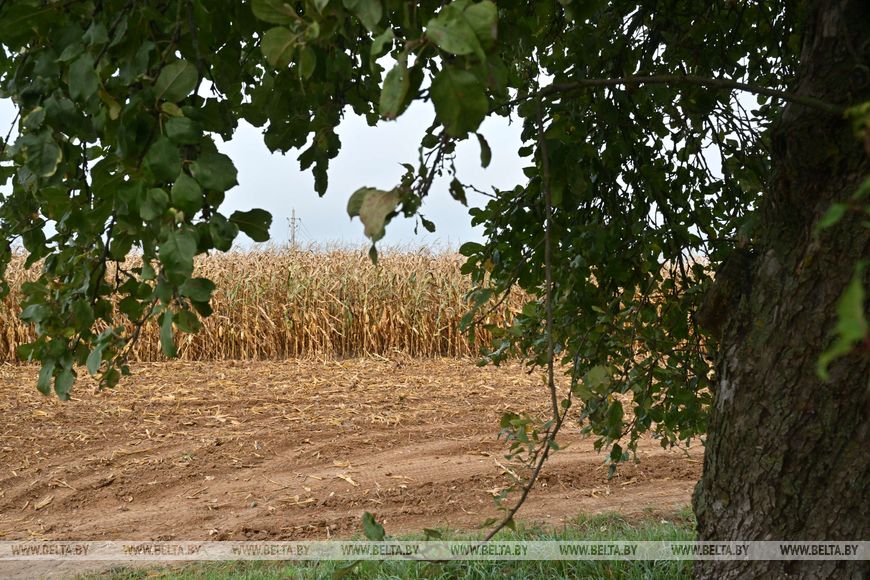
What about seed prices?
As far as prices for Belarusian and foreign seed hybrids are concerned, domestic hybrids remain beyond competition. For many farms, it can be a decisive factor, rather than a potential opportunity to harvest a little more.
Leonid Shimansky said that he had discussed this issue with the head of Shklov District in the run-up to the president's visit. In general, this year the district purchased Belarusian seeds for Br2,700 to Br3,600 per tonne with an average equivalent price of $1,000, which is about $30 per hectare. This is significantly lower than the price of the same sowing units from foreign companies, which starts from €130, a fourfold difference. Not every farm can afford such expenses. Moreover, they also need to apply herbicides and nitrogen fertilizers at a cost of Br150-200 per hectare each.
"We can buy herbicides and nitrogen fertilizers only thanks to the price difference," the scientist said. "Economics matters not only within an individual farm but across the board." This approach is very important for medium-sized farms that expect good results with relatively small investments.
Does the country have enough domestic seeds?
The answer to this question depends on the goal. Nowadays, Belarus has two maize calibration plants, in Gomel Oblast and Brest Oblast, with a total seed production capacity of about 25,000 tonnes per year. In total, the country needs about 33,000 tonnes of seeds.
"Last year was good for the seed industry. We produced even more than 30,000 tonnes of seeds. The average production remains 19,000-21,500 tonnes at two plants, with the annual sale of 19,500 tonnes."
On the one hand, there is a lack of domestic seed supply. Sometimes even silage production target are not achieved. On the other hand, farms and regions sometimes intentionally purchase imported seeds. Aleksandr Lukashenko does not call for giving up on imports completely. A minimum of 15% foreign hybrids may still be used to compare the results with.
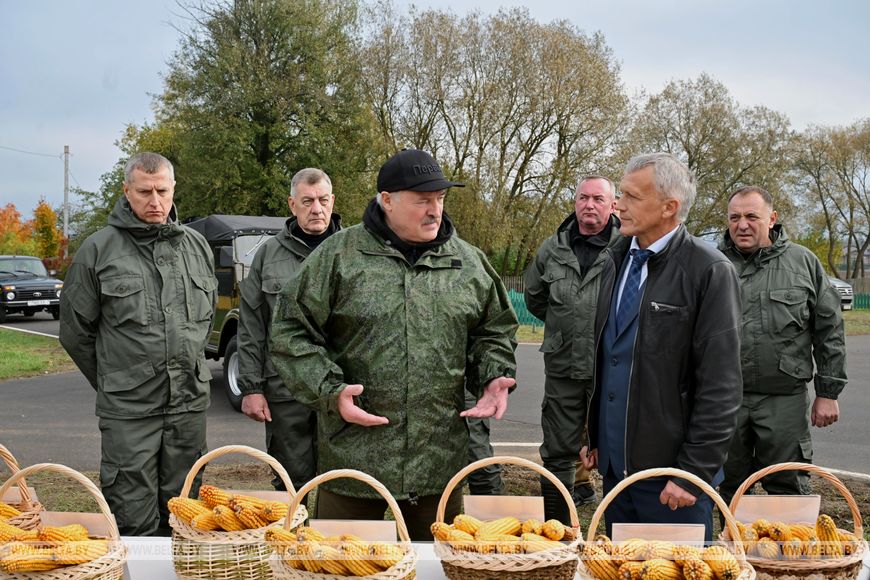
Therefore, the issue of seed production growth is debatable. It is possible to increase the existing capacities or to think over the construction of a third maize calibration plant, for example. "This issue is very important and needs to be carefully considered," the scientist noted. "These two [plants] have been built thanks to the president. Only his support made building the first one possible. Then we proved that we needed the second one while initially there were plans to build only one. Initially the output stood at 5,000 tonnes, then 7,000, then 10,000. Then it went all the way to 12,500. The second plant was built thanks to the president as well.”

Well, time will tell. It is easier to achieve record harvests in greenhouse conditions, where scientists know practically every plant. Another thing is to repeat the success on a larger scale. "There are a lot of factors that can affect the seed industry, such as low or high pollination intensity. It would be better to eliminate these factors, but we do not always succeed. It does not mean that our seed industry is lagging behind. We still achieve good results, collect high-quality seeds," the director of the institute said. "After all, our hybrids have passed state variety testing and have been included in the register."
Despite the climatic constraints, Belarusian scientists are still working on grain hybrids. "We need to focus on our silage and grain varieties. Trust me, we will have grain. Our grain hybrids are on the way. They are promising," Leonid Shimansky said.

What about seed prices?
As far as prices for Belarusian and foreign seed hybrids are concerned, domestic hybrids remain beyond competition. For many farms, it can be a decisive factor, rather than a potential opportunity to harvest a little more.
Leonid Shimansky said that he had discussed this issue with the head of Shklov District in the run-up to the president's visit. In general, this year the district purchased Belarusian seeds for Br2,700 to Br3,600 per tonne with an average equivalent price of $1,000, which is about $30 per hectare. This is significantly lower than the price of the same sowing units from foreign companies, which starts from €130, a fourfold difference. Not every farm can afford such expenses. Moreover, they also need to apply herbicides and nitrogen fertilizers at a cost of Br150-200 per hectare each.
"We can buy herbicides and nitrogen fertilizers only thanks to the price difference," the scientist said. "Economics matters not only within an individual farm but across the board." This approach is very important for medium-sized farms that expect good results with relatively small investments.
Does the country have enough domestic seeds?
The answer to this question depends on the goal. Nowadays, Belarus has two maize calibration plants, in Gomel Oblast and Brest Oblast, with a total seed production capacity of about 25,000 tonnes per year. In total, the country needs about 33,000 tonnes of seeds.
"Last year was good for the seed industry. We produced even more than 30,000 tonnes of seeds. The average production remains 19,000-21,500 tonnes at two plants, with the annual sale of 19,500 tonnes."
On the one hand, there is a lack of domestic seed supply. Sometimes even silage production target are not achieved. On the other hand, farms and regions sometimes intentionally purchase imported seeds. Aleksandr Lukashenko does not call for giving up on imports completely. A minimum of 15% foreign hybrids may still be used to compare the results with.

Therefore, the issue of seed production growth is debatable. It is possible to increase the existing capacities or to think over the construction of a third maize calibration plant, for example. "This issue is very important and needs to be carefully considered," the scientist noted. "These two [plants] have been built thanks to the president. Only his support made building the first one possible. Then we proved that we needed the second one while initially there were plans to build only one. Initially the output stood at 5,000 tonnes, then 7,000, then 10,000. Then it went all the way to 12,500. The second plant was built thanks to the president as well.”
Speaking about the shortage of seeds, Leonid Shimansky also raised the matter of developing highly efficient manufacturing: “If our agricultural enterprises don’t pay close attention to it, then nothing will grow. Regardless of whether they are Belarusian seeds or imports. As I always say, don’t complain that crop breeders are bad. Let’s take a look at how maize is cultivated.”
So, if arable farming achieves higher standards, then it will need fewer maize seeds in comparison with how much is used at present. The crop breeder may be a bit idealistic about it but one has to admit that he is at least partially right.

“We could reduce the volume of seeds if we optimized the structure of the area under crops. We could reduce the area under maize. There is no need to be afraid of it. We shouldn’t dilute [resources]. We should concentrate them. And get bigger returns from smaller areas. We could apply organic fertilizers, crop protection agents, and mineral fertilizers there. It is a possibility worth looking into. The spare land could be used to grow other crops, including grass,” the scientist suggested. “We could resolve the problem of seeds if we embraced intensive solutions. We would have totally different returns.”
Indeed, it is impossible to feed cattle only with maize silage. It will be harmful for the animals. It is necessary to balance the diet and mix silage with grass forage roughly evenly.
Conclusion?
If we talk about advantages of Belarusian varieties, the fact that they are regionalized to meet local climatic conditions comes to mind first. In other words, they are less demanding in comparison to imports. It means that they can be used by average-performance agricultural enterprises where arable farming standards are not always top notch. And then there is the price factor: Belarusian seeds are much cheaper. And if we do not need grain but silage, then there is no point in paying extra for imports. On the contrary, the saved money can be spent on fertilizers, all kinds of tilling operations in order to get proper returns from Belarusian seeds.
There is another point that has not been voiced yet but seems important. Belarusian seeds also contribute to food security. If something happens to deliveries of French, German varieties or any other ones, Belarusian varieties are always available. With proper care they can produce silage and grain. Frankly speaking, the yields the presidential field demonstrates are way above the country’s average. Even on better soils.
This is why we can afford making another conclusion on our own: if everything is done on time and according to the technology, as Aleksandr Lukashenko emphasizes all the time, then there will be plenty of maize and other crops regardless of foreign or Belarusian seeds.
And one final point. One has to admit that Belarusians are prone to criticizing domestic products in comparison with imports. Since they believe that domestic products are worse, they are less willing to invest in them. And we are talking not only about financial investments but process discipline and labor.

“For some reason when we buy imported maize, then we [agricultural enterprises] pour everything into it and work hard. If we deal with Belarusian varieties, we don’t work as hard. I don’t know when the attitude can be reversed. There is no need to be afraid of Belarusian maize. It is quite good. It is just a crop like foreign ones. Only it is Belarusian. This is why don’t be afraid!” Leonid Shimansky said in conclusion of the conversation.







